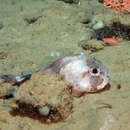Diagnostic Description
provided by Fishbase
Four bony knobs between and behind the eyes. Skin very rough. Body with 3-4 broad, dark vertical bands (Ref. 35388).
- Recorder
- Arlene G. Sampang-Reyes
Trophic Strategy
provided by Fishbase
Benthic (Ref. 58426). Feeds on polychaetes, mysids, amphipods and pycnogonids (Ref. 6696). Consumed primarily benthic organisms (Ref. 51343). Parasite found was a copepod, Chondracanthus cottunculi (Ref. 5951). Almost no information on this genus (Richards, ed. 2006) No information on behavior (Ref. 86779).
- Recorder
- Drina Sta. Iglesia
Biology
provided by Fishbase
Benthic (Ref. 58426). Feeds on polychaetes, mysids, amphipods and pycnogonids. Spawns probably from June to July, ovarian eggs large and few (up to 220) (Ref. 6696). Female lays 200 eggs with a length of 4.5-5 mm (Ref. 35388).
Importance
provided by Fishbase
fisheries: of no interest
Cottunculus microps
provided by wikipedia EN
Cottunculus microps, the polar sculpin, is a species of fathead sculpin, a deepwater fish found in the North Atlantic and Arctic Oceans.[2] It was first described in 1875 by the Norwegian zoologist Robert Collett, curator of the Natural History Museum at the University of Oslo.
Description
Like other members of its family, the polar sculpin has a large head, a short tapering body and a small tail. The skin is loosely attached and there is a gelatinous layer beneath it.[3] This fish has a maximum length of about 30 cm (12 in) but a more usual length is between 9 and 14 cm (3.5 and 5.5 in). The head is rounded when viewed from above; its width is usually greater than its length. There are four rounded bony knobs behind and between the eyes and the skin is very rough. The colour of this fish is greyish-brown and there are three or four broad, dark-coloured vertical bands on the sides of the body. The dorsal fin has about 7 spines and 14 soft rays and the anal fin 10 to 11 soft rays. The pectoral fins are pale-coloured with a few dark spots and have 17 to 19 soft rays.[4][5]
Distribution and habitat
The polar sculpin is native to the North Atlantic Ocean and the Arctic Ocean. In the western Atlantic it is found from New Jersey in the United States northward to the Gulf of Saint Lawrence in Canada and Greenland. In the eastern Atlantic it is found in the English Channel, the North Sea, Norway, the Barents Sea, Svalbard, the Faroe Islands and Iceland. It is a demersal, deep sea fish found near the sea bed at depths ranging between 165 and 1,340 m (540 and 4,400 ft), but mostly no deeper than 215 m (700 ft).[5]
Ecology
The polar sculpin is a demersal fish and feeds on various invertebrates that live on the seabed including polychaete worms, amphipods, mysid shrimps, sea spiders and other crustaceans.[1][5] The life history of this fish is little known; females have been caught containing 124 to 220 nearly ripe eggs, each measuring up to 4.5 mm (0.2 in) in diameter. It is likely that like some of its close relatives, the eggs of the polar sculpin develop on the seabed and the larvae may also be demersal.[3]
References
-
^ a b Bailly, Nicolas (2008). "Cottunculus microps Collett, 1875". WoRMS. World Register of Marine Species. Retrieved 19 February 2017.
-
^ Byrkjedal, I.; Hadler-Jacobsen, S.; Rees, D.; Orlov, A. (2014). "Molecular and morphological variation in saddled fathead sculpins (Psychrolutidae: Cottunculus) of the north-east Atlantic Ocean, with a synonymy of three species". Journal of Fish Biology. 85 (3): 821–837. doi:10.1111/jfb.12458. PMID 25041434.
-
^ a b Richards, William J. (2005). Early Stages of Atlantic Fishes: An Identification Guide for the Western Central North Atlantic. CRC Press. p. 1191. ISBN 978-0-203-50021-7.
-
^ "Polar sculpin (Cottunculus microps)". Fishes of the NE Atlantic and the Mediterranean. Marine Species Identification Portal. Retrieved 19 February 2017.
-
^ a b c Froese, Rainer; Pauly, Daniel (eds.) (2023). "Cottunculus microps" in FishBase. February 2023 version.

- license
- cc-by-sa-3.0
- copyright
- Wikipedia authors and editors
Cottunculus microps: Brief Summary
provided by wikipedia EN
Cottunculus microps, the polar sculpin, is a species of fathead sculpin, a deepwater fish found in the North Atlantic and Arctic Oceans. It was first described in 1875 by the Norwegian zoologist Robert Collett, curator of the Natural History Museum at the University of Oslo.
- license
- cc-by-sa-3.0
- copyright
- Wikipedia authors and editors
Diet
provided by World Register of Marine Species
Feeds on various bottom-living invertebrates including polychaetes, amphipods, and other crustaceans.
North-West Atlantic Ocean species (NWARMS)
- license
- cc-by-4.0
- copyright
- WoRMS Editorial Board
Distribution
provided by World Register of Marine Species
Western North Atlantic coast as far north as Smith Sound, through Baffin Bay; from the Gulf of St Lawrence off Nva Scotia, southward to southwest Browns Bank
North-West Atlantic Ocean species (NWARMS)
- license
- cc-by-4.0
- copyright
- WoRMS Editorial Board
Habitat
provided by World Register of Marine Species
Benthic marine species taken at depths of 201- 896m.
North-West Atlantic Ocean species (NWARMS)
- license
- cc-by-4.0
- copyright
- WoRMS Editorial Board
Habitat
provided by World Register of Marine Species
benthic
North-West Atlantic Ocean species (NWARMS)
- license
- cc-by-4.0
- copyright
- WoRMS Editorial Board

